This post contains a referral link*
In late November, I wrote a blog post about the most interesting health gadgets for 2021. Shortly after publishing that blog post, Veri caught my attention (formerly known as Veristable). If I had known Veri and CGM earlier, I would have included it in that post.
During that time, I didn’t know much about blood sugar, how to monitor it, and would it be even relevant for non-diabetics.
Now, after 14 days of continuous blood sugar monitoring and reading through the scientific literature, a totally new health landscape has opened in front of my eyes. Join the ride with me!
Ps. You can use my referral link to get 30 dollars off from your first Veri sensor order or use code VSM-ILMOST
Table of Contents
1. Why should you measure your blood sugar levels as nondiabetic?
Blood sugar is what it says: sugar in the blood that comes from the food we eat. Our digestive system breaks down carbs for the body’s fuel. In simple, the more we eat carbs or sugary products, the higher the blood sugar levels will be.
Continuous blood sugar monitoring is an important activity for diabetics to ensure they are on recommended target ranges and avoid harmful complications. Nondiabetics get their blood sugar check from routine blood tests done once a year or less frequently.
Let’s say that your routine fasting blood test tells that you are inside the recommended target range – why should you measure it more?
More importantly, many scientific studies have concluded a significant risk difference between values in the normal range. According to ADA, normal fasting plasma glucose values should be less than 100 mg/dl [6]. That being said, risk increases when fasting blood glucose is greater than 85 mg/dl [7], and with 91-99 mg/dl, there was a 3-fold risk increase in type 2 diabetes compared to values below 83 mg/dl [8].
We can also look at this from a longevity point of view, which respected MD Peter Attia has highlighted in many podcasts. The most deadly chronic diseases are heart disease, cancer, and Alzheimer’s. Interestingly, type 2 diabetes is a common factor behind these deadly diseases, making them worse. [9] [10] [11]
CDC has estimated that over 25% of the US population are prediabetic, meaning that their blood sugar levels are higher than normal but not high enough to be diagnosed as type 2 diabetes [12]. In my home country Finland, estimations say that a little bit under 20% of the population is prediabetic [13].
Luckily, Levels health published an excellent article [14] on healthy blood sugar levels – based on scientific studies, they concluded the following recommendation for optimal levels:

Blood sugar and sleep have a bidirectional connection. Sleep problems increase the risk of type 2 diabetes, and frequent irregular blood sugar levels are usually seen in people with sleep apnea. [15] Blood sugar is also connected to performance – both mental and physical. Unstable blood sugar levels can cause mental fog and lethargic workouts.
In conclusion, if you are interested in a preventative lifestyle and longevity, continuous blood sugar monitoring is for you. If you want to get more out of your day and optimize your energy levels, it’s for you. If you have close relatives with type 2 diabetes (like I have), it’s for you.
So, how do you monitor your blood sugar levels continuously? Insert Veri!
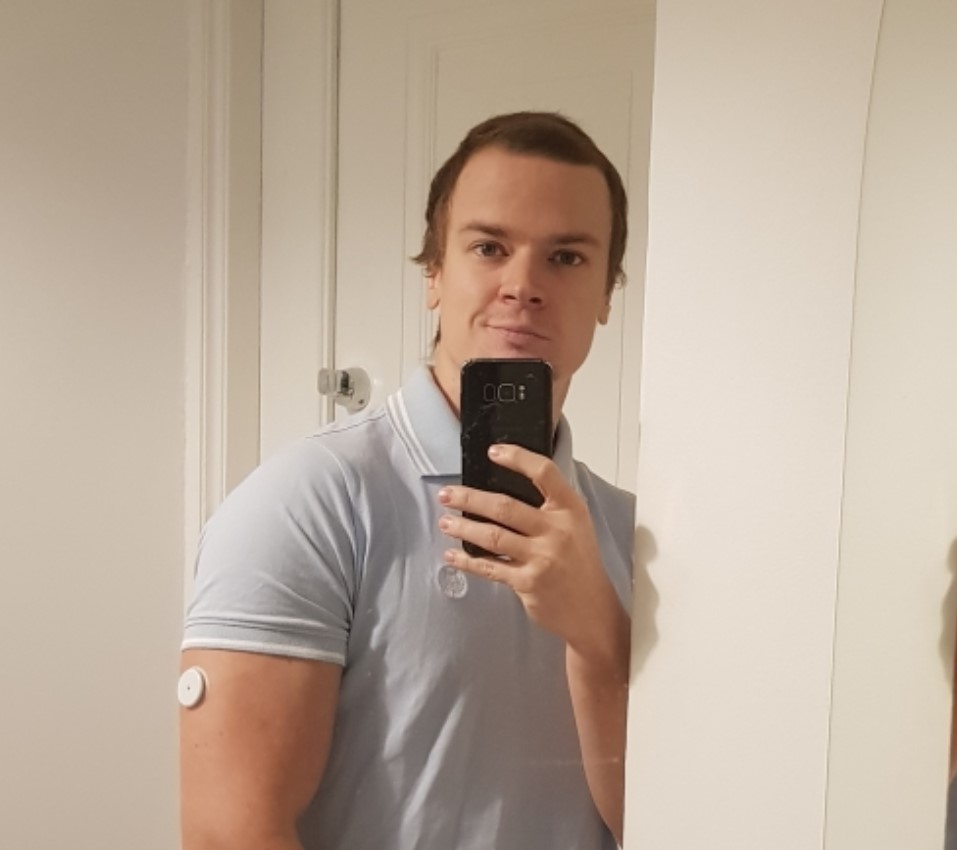
2. Veri review
In this part, I will review Veri as a product and service. Veri is a small and young Finnish-based company.
What is Veri’s product?
It is called veri (blood in Finnish) – It consists of a sensor and Veri app. One sensor lasts 14 days.
Pricing & Availability
109€ for one sensor (14 days) and 159€ for two (28 days). However, you get 20% discount with following code.
The app is available in Europe and The United States.
Applying the sensor and getting everything ready
Quick start instructions were clear on the Veri app. The sensor is applied to the back of the upper arm. The sensor has a tiny flexible needle (it didn’t hurt). After that, there is a one-hour calibration process.
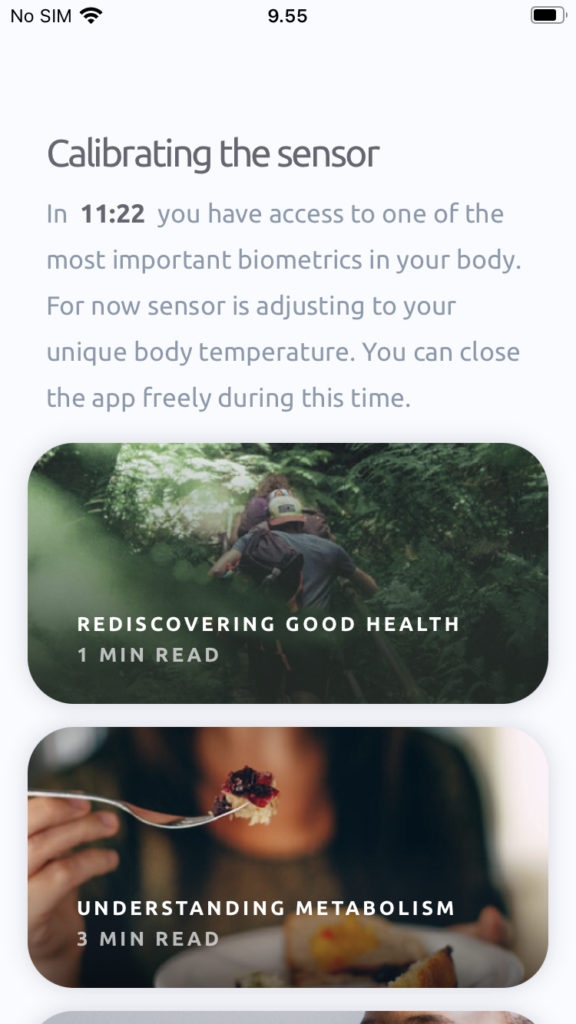
How does it work?
A tiny flexible needle reads blood sugar. To get data visual, you have to scan the sensor with your phone (put the phone’s camera close to the sensor)
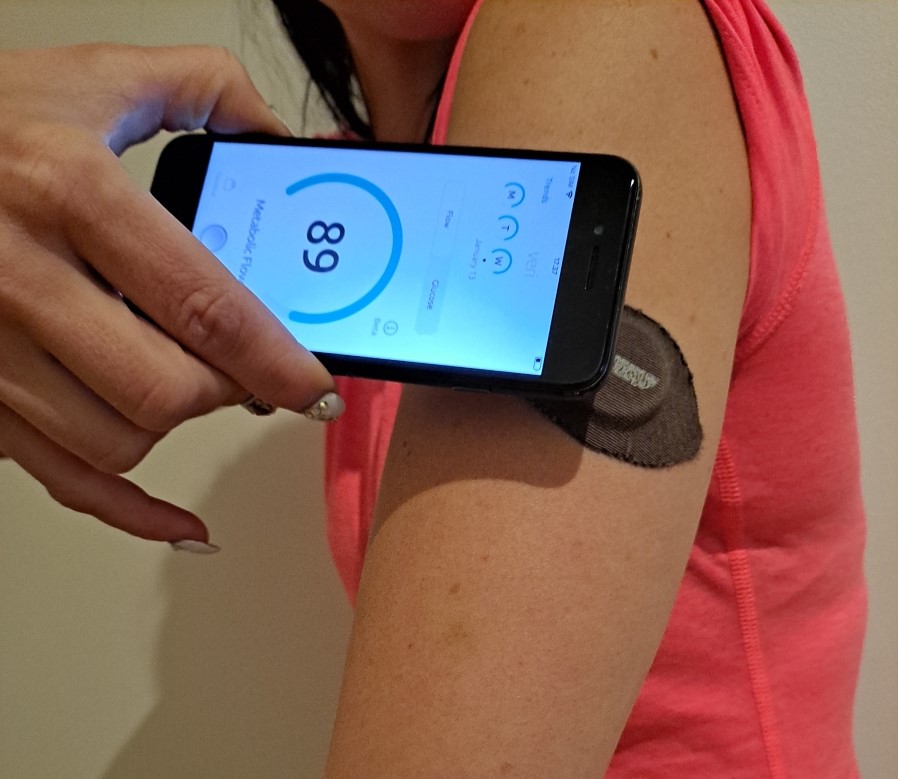
After that starts the exciting part, the app visualizes the current blood sugar level. There is also high and low mark based on users average levels.
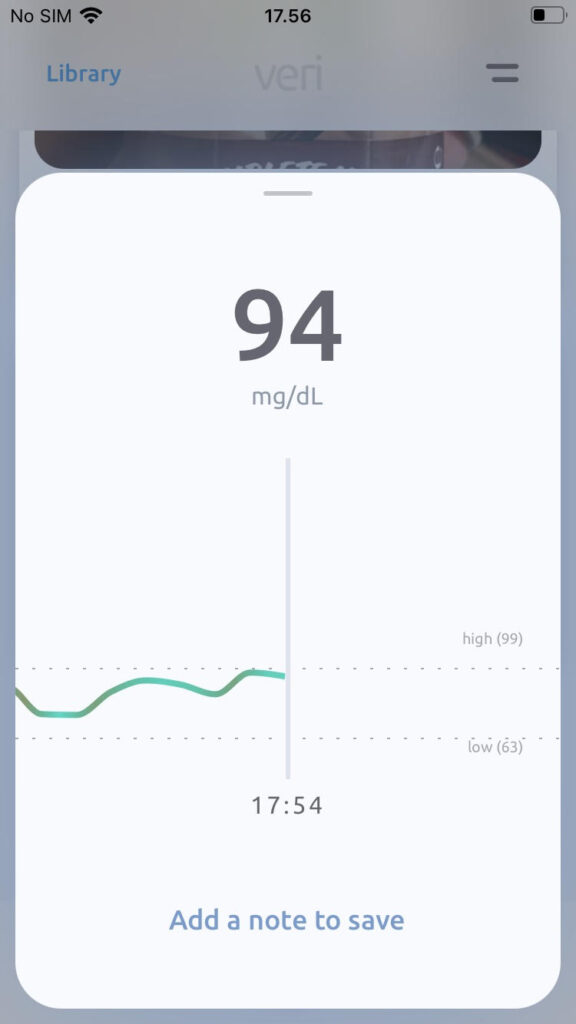
According to their CEO, they are working to make high & low marks more personal based on users’ age, weight, and diet. This is an excellent decision as we are all individuals with a different backgrounds.
Different metrics to understand your body
With Veri, it isn’t just about blood sugar levels; there are many different interesting metrics. Let’s go them through one by one:
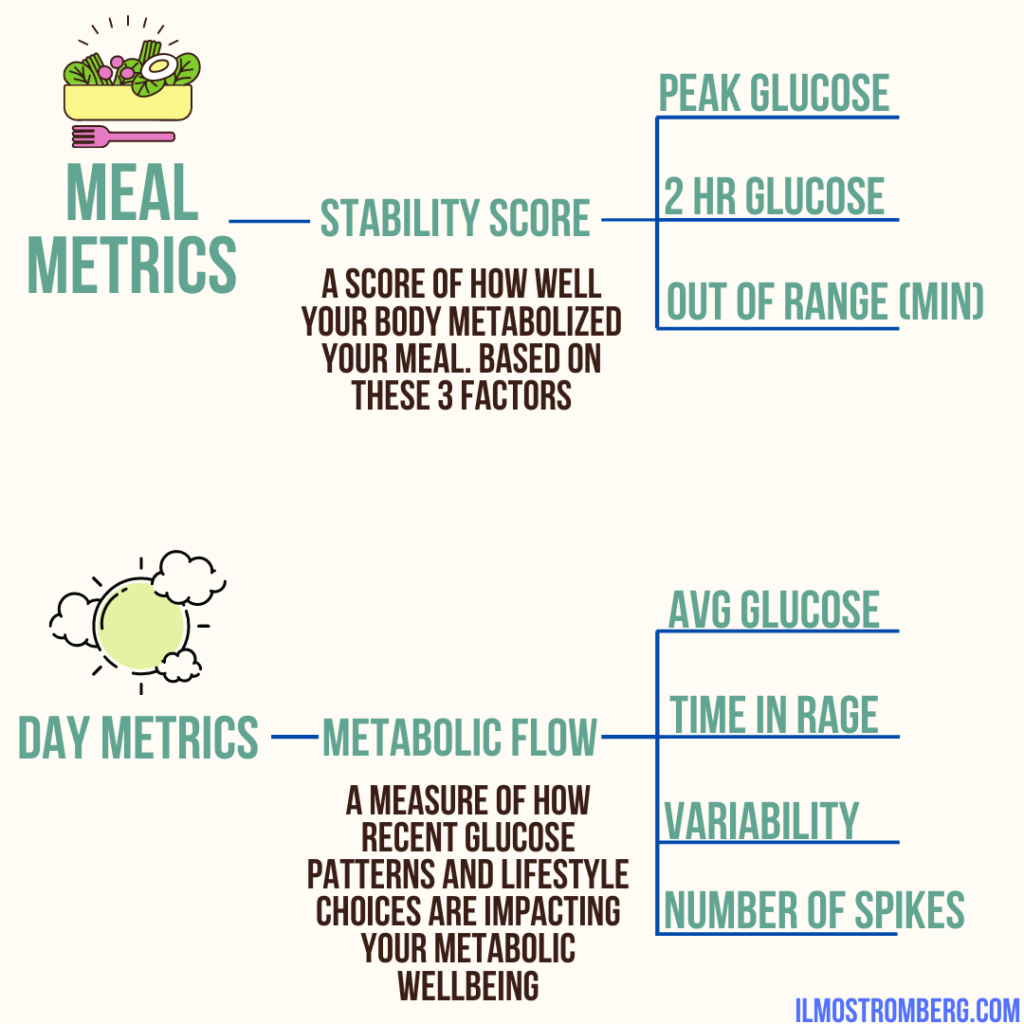
Stability score is connected to each meal you eat; it’s calculated from peak glucose, glucose after 2 hours, and how many minutes you were out of the range (over the established high value). Healthy food like salmon salad gave me a stability score of 9/10, which is a good number. Peak glucose was minimal, and in 2 hours, my blood sugar levels were in the average range.
Metabolic flow combines the data from the day and scores that (Maximum score of 100).
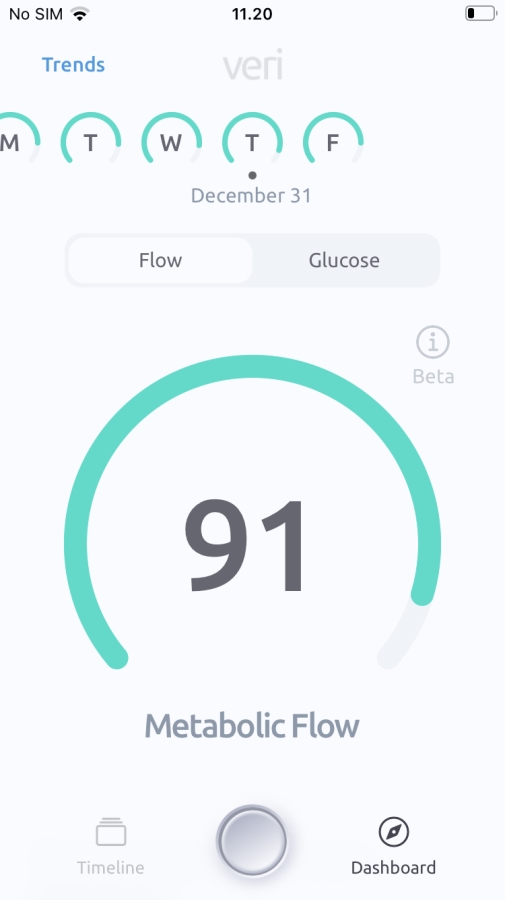
One of the factors is time in the range – you want to be in the optimal range, based on a weekly average of +- 18 mg/dl. Variability, other hands, measures how much glucose deviates from average each day. Target is to be under 11.
The last metric is the number of spikes in the day. Obviously, you want one or zero spikes for the day. Here we have one clear spike in the morning:
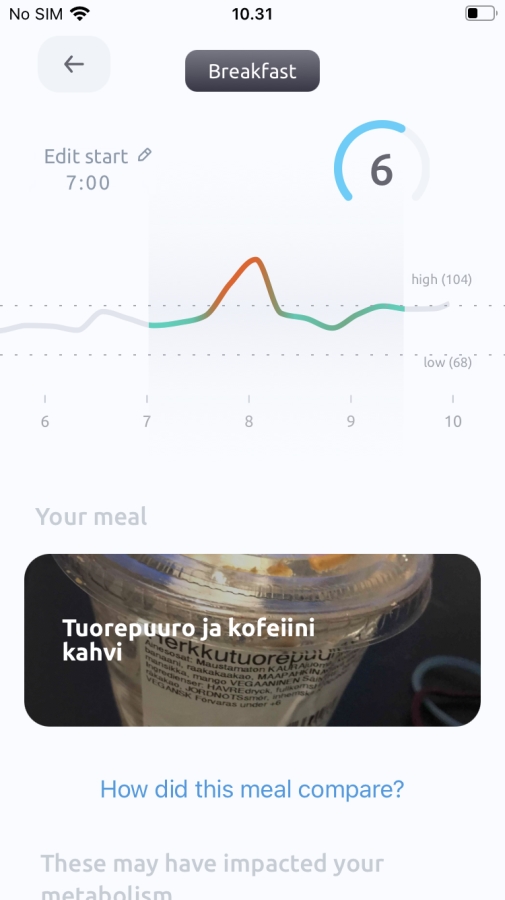
Veri has done a great job with metrics and how the data is visualized in the app. I especially like the idea of taking a picture of your meal, and then the stability score is connected to your meal. It’s a very powerful message – what works and what doesn’t. You can also sort meals by stability score to get a quick overview. Things like that make the user experience excellent.
You can also monitor your blood sugar levels during exercise. Apple health works for this as an exercise logging platform, and from there, it’s automatically synced into veri app.

This is a good feature for all you exercise freaks that want to optimize the performance during training. Veri gives the following explanation for fuel source information:
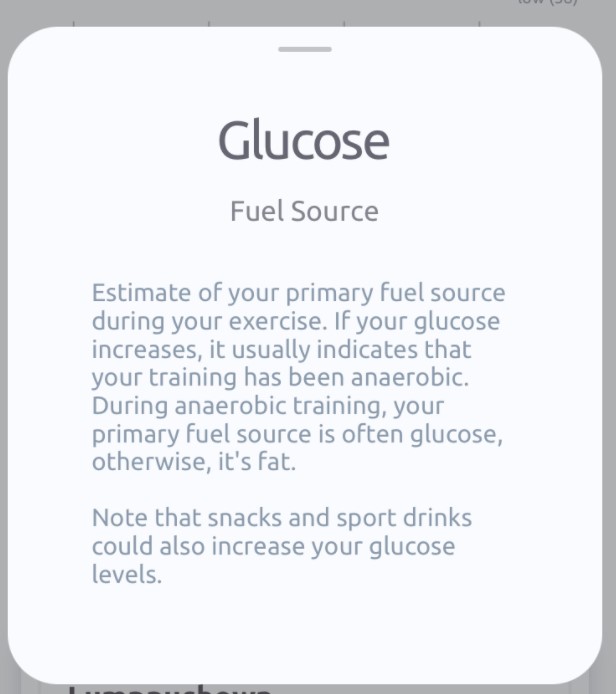
You can also add sleep data from apple health, but I didn’t use that feature. I analyzed my Oura sleep data during this 14 days period; more on that in the next part.
After 14 days, you get the final report, which summarizes the results. The final report was comprehensive and easily understandable.

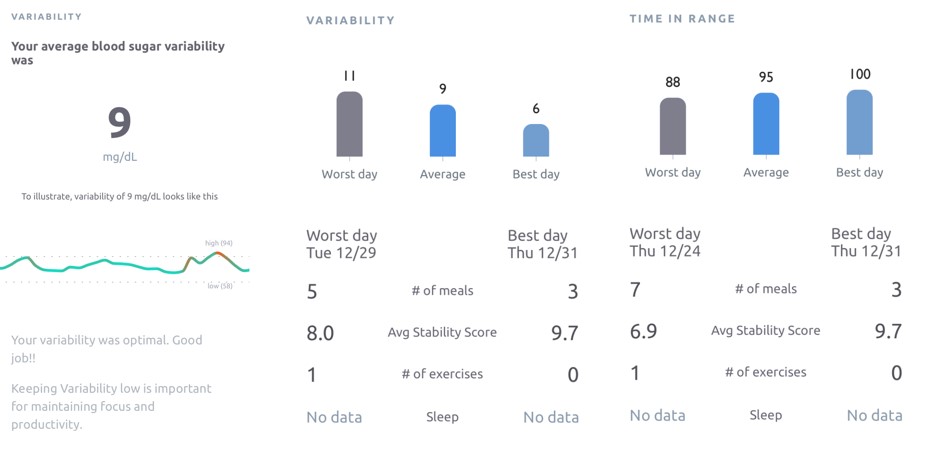
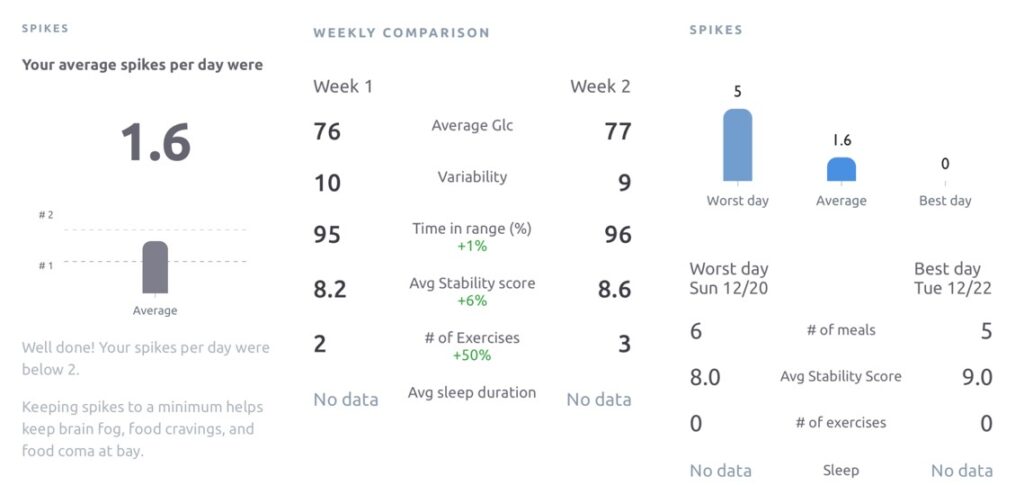
Positives about Veri
- The App is well build
- Comprehensive metrics
- Good small (1-3 min read) articles on the app to get more understanding of blood sugar and how different things affect it.
- Solid Veri community where you can discuss with other users or get a fast answer from Veri representatives.
Negatives about Veri
- Currently only available in iOS (I learned it the hard way, I had to buy the cheapest iPhone for this). Update: Now availabe in android too!
- Sauna or extremely cold environments can give false readings.
Summary & Rating
Veri’s slogan is “Your compass for metabolic health.” I truly believe this is something that we need for healthier and longer life. I really liked the app and all the metrics; in that sense, Veri exceeded my expectations.
There are still things to improve, like sensor problems (data quality is the most important thing), but that’s natural as the product is still in the early access phase.
In my opinion, 129€ isn’t a bad price for understanding your metabolic health. 14 days is enough to understand what works and whatnot, especially if you have a steady diet.
3. What Did I learn in 14 days of continuous blood sugar monitoring?
Now starts the most interesting part!
Before starting the experiment, I already had one idea that I wanted to test; How does a post-lunch walk affect blood sugar levels.
Post lunch walk/standing and blood sugar levels
For this, I chose a 12-inch long subway tuna sandwich, which I ate two consecutive days for lunch. I tried to keep all the other variables the same: breakfast, bed- and woke uptime.
Subway’s official calculator reveals the following nutrition information regarding footlong sub.

We can safely say that 75 grams of carbs should spike my blood sugar levels. Let’s start with the stability score for each day


It seems like walking had a significant positive effect on blood sugar levels. However, when walking stopped, there was still a minor blood sugar spike. Let’s look the details more in-depth:

I believe that If I had continued the walking 30 minutes more, there probably wouldn’t be any spike.
Another day I ate 600 grams of salmon lasagne for lunch, and after that, I stood for 3 hours straight. I was blown away when I looked at the blood sugar levels:
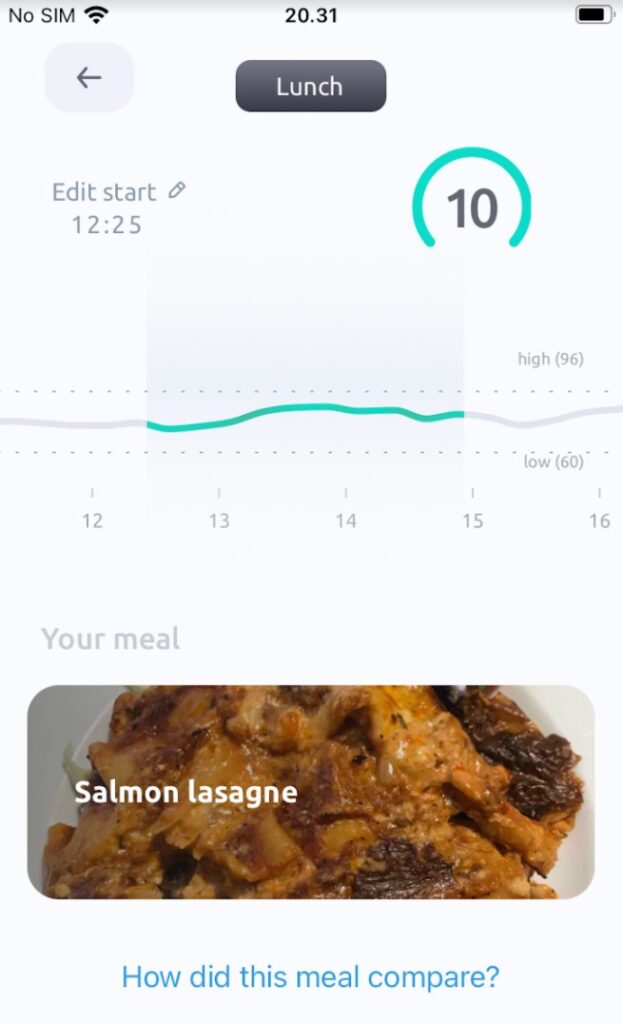
According to myfitnesspal, salmon lasagne has around 60 grams of carbs when the total weight is 600 grams. Veri gave a stability score of 10 as peak glucose was 85 mg/dl, and in 2 hours, it was 80 mg/dl. I was fascinated by this result, so I had to find scientific studies to back this up, especially when I didn’t test the same scenario without standing.
One study found that 2 hours of standing in the office reduced post-lunch blood sugar spikes, mindblowing 43 percent! [16]
Lastly, it’s important to point out that just because there weren’t blood sugar spikes doesn’t mean it’s a healthy meal.
Christmas and blood sugar
I was lucky (or unlucky) when Christmas was part of my 14-day experiment. There was no surprise that on Christmas eve, I had the worst scores on metabolic flow. For lunch, I had a big bowl of rice porridge with blueberry soup. I was used to getting good scores, so it was also interesting to see the other end of the scorecard.
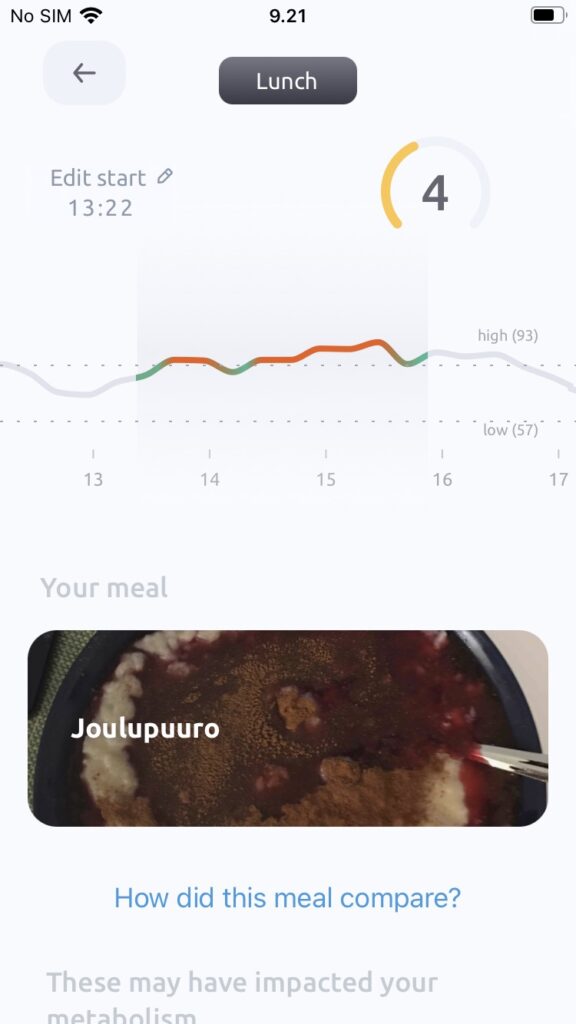
On Christmas eve metabolic flow scores were 82 – how far away was it from the total average?

It was a surprise that my lowest scores weren’t far away from my average (86).
Based on this picture, it’s relevant to recognize what I ate days with 82-83 scores and 91 & 93. The common nominator for worst scores was snacking (chocolate, banana, fruits, and gingerbread). There was no snacking on the best days; I ate healthy salads and even pasta/lasagne a few times (see the standing experiment).
I’m a big proponent for healthy snacks, so it was awesome to see that I got 9 or 10 scores with them (example: Kombucha, plum sour cream, vegetable blueberries smoothie, collagen protein bar)
Combining sleep data (Oura) with Veri
To understand the full picture and how everything is connected, it’s relevant to combine data from other sources. Like in the first part stated, sleep and blood sugar are connected. If there is a problem in either area, it could affect the other one also.
I combined all the variables from Oura and Veri and started to look at correlations. There was one that strikeout. A number of spikes per day and sleep efficiency. I don’t like to make conclusions based on 14 days of data, but this is definitely interesting:
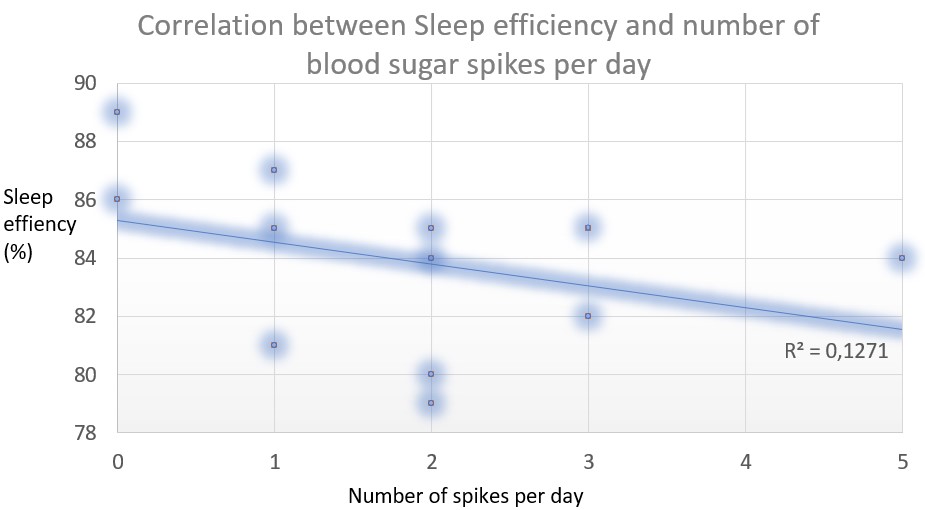
It seems that the more I have blood sugar spikes during the day, the worse my sleep efficiency will be. My girlfriend is currently experimenting with Veri, so I gather more data from her once the 14 days are up.
Key takeaway
Can you imagine a biohacking device that could reduce your blood sugar spikes by 50%, improve your sleep, energy levels, and mental clarity? You could probably sell this device for hundreds of dollars. The good news is that you don’t need any device, stand 2 hours after lunch, walk 30 minutes, and get the benefits.
I have been a proponent for a post-lunch walk and standing for a while, but this reinforces it when you can quantify it.
My understanding of metabolic health has increased significantly during the last month, and it’s definitely something that I will keep studying and writing about that.
A good way to end this is with Leonard da Vinci quote

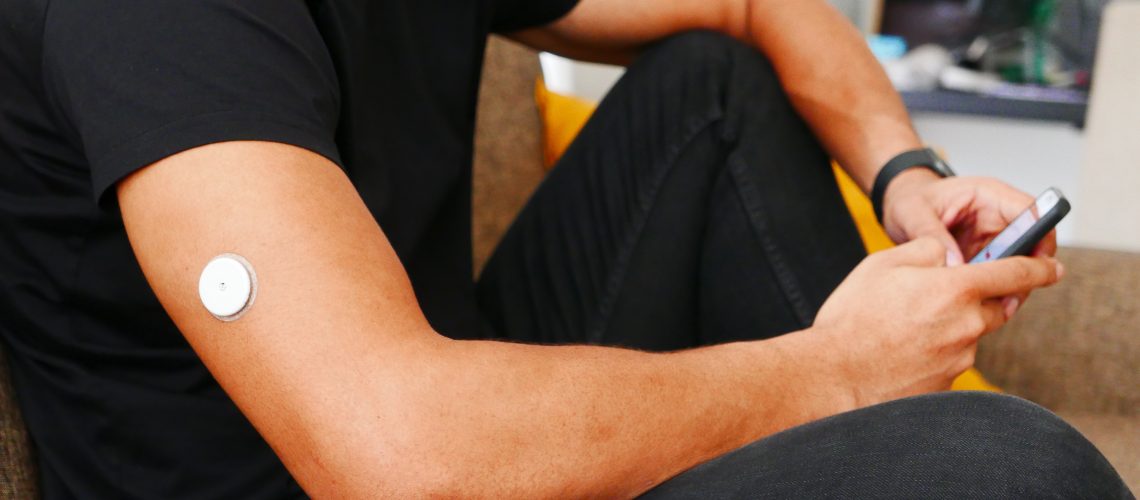
This Post Has 19 Comments
Excellent post. I’m currently at day 4 of wearing the Veristable sensor. Fascinating so far
Thank you Jason. Would be interesting to hear your results after 14 days! Do you have any specific experiments on the mind?
Hi Ilmo. I’m an Ironman triathlete, so the focus for me is trying to find the correct level of carbohydrates to fuel training, both between sessions and during them. But also aware of how easy it is to overeat carbohydrates and the potential impact in long-term health. Trying out different fuel sources during bike rides (solid vs liquid) has already suggested some differences. Thanks again for your blog
Really enjoy reading your posts. I have a similar blog where I post in my own language (Dutch) and you’ve inspired me to do more experimenting.
Thanks and keep it up!
Thanks Ray, really appreciated it. Your page looks good even though I cannot understand the content
Great post very interesting
Great stuff Ilmo. I’m currently wearing the Levels/Freestyle Libre. Outside of sleep efficiency did you notice any other correlations between sleep quality and glycemic variability? For example, any noticeable effects on amount of deep/REM, RHR, HRV, etc.?
Hi Jon
Thanks for the comments. There was only a clear correlation with sleep efficiency. 14-day experiment was also divided into the Christmas holidays and normal workdays. How long will you experiment?
Thank you! Great and useful review.
Ilmo, have you found your food sensitivities to certain products?
Hi Oleg
Thanks for the comments. I also thought this as Ben Greenfield point this out a while ago (allergy -> Cortisol -> rise in blood sugar levels), but nothing struck out in the 14-day experiment
So interesting, thanks for all the great info!
Thanks!
Were the gaps in the data due to the sensor not being scanned for more than 8 hours?
no, it was something else.
Great post! I am excited to try Veri out myself but I still have some doubt as to how accurate those blood sugar levels are.
I have notable result differences on the first sensor vs second/third sensor. I will write a new post where I will look into this.
Interesting to see non-diabetics using these products to better their health. In your first picture, I think you have the device a little too forward for optimal testing — further back on the arm would have given you more subcutaneous tissue to work with and a lesser chance of damaging the canula during day-to-day activities!
Thank you for the comment, I will keep that in mind when I insert the device next time
Very interesting infos. I was looking for an objective opinion not involved in the brand. Tks for your blog